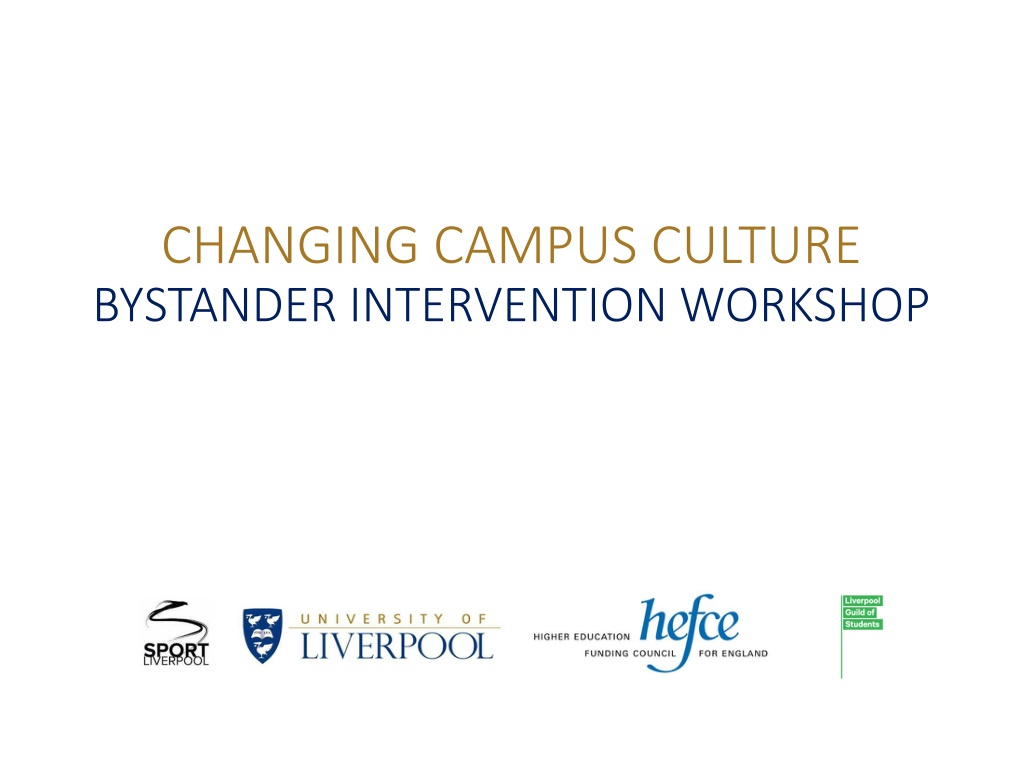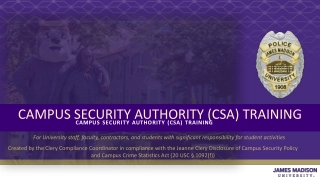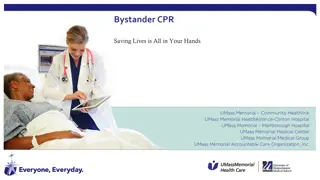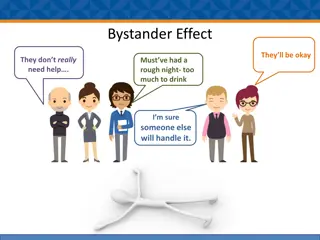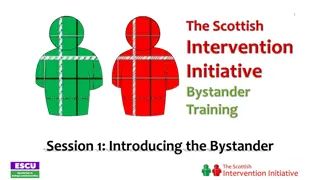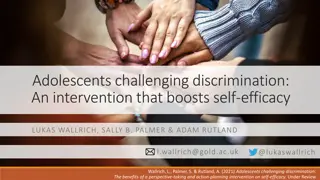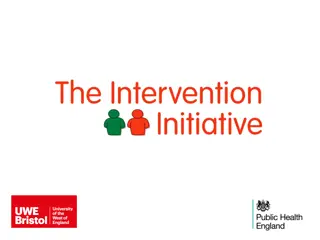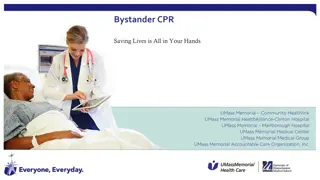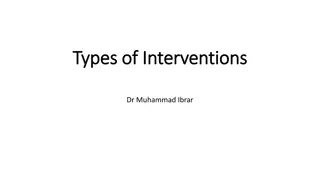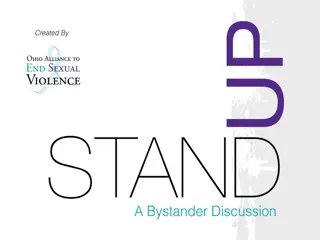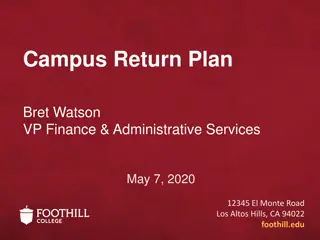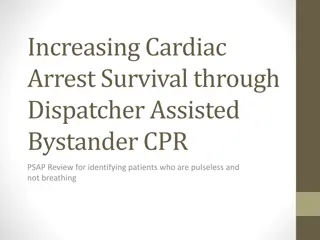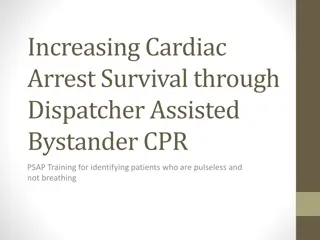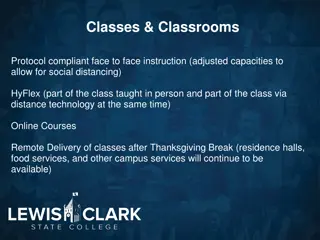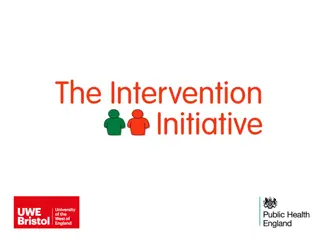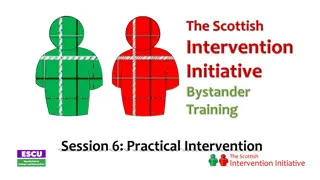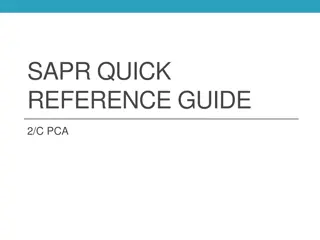Creating Safe Campus Environments: Bystander Intervention Workshop Overview
Explore the dynamics of bystander intervention through a workshop addressing sexual misconduct and online harassment. Gain knowledge, skills, and empowerment to challenge and prevent such incidents. Statistics reveal the prevalence of these issues, emphasizing the importance of creating a safe and welcoming campus environment for all. Join us to learn, reflect, and work towards a culture of respect and intervention.
Download Presentation

Please find below an Image/Link to download the presentation.
The content on the website is provided AS IS for your information and personal use only. It may not be sold, licensed, or shared on other websites without obtaining consent from the author. Download presentation by click this link. If you encounter any issues during the download, it is possible that the publisher has removed the file from their server.
E N D
Presentation Transcript
CHANGING CAMPUS CULTURE BYSTANDER INTERVENTION WORKSHOP Image result for the guild of students liverpool logo Image result for sport liverpool logo
Workshop We will be covering some sensitive material within the workshop including scenarios on sexual misconduct and online harassment. Workshop Code of Conduct Phones Confidential Environment Respect each others opinions, beliefs and values
AIMS & OUTCOMES AIMS: Learn about sexual misconduct and feel empowered to challenge it Learn about online harassment and feel empowered to challenge it OUTCOMES: Improve our knowledge and understanding of sexual misconduct and online harassment. Improve our knowledge and understanding of a bystander Explore scenarios and develop our bystander intervention skills
SESSION OVERVIEW Sexual Misconduct Online harassment Types of Bystander Approaches to Bystander Intervention Being a Bystander Scenarios Reflection
TASK You have 2 minutes to come up with 3 words which describes your sports club/ society Be creative, these words should highlight your sports club s/ society s culture, environment, tradition, and everything else which makes it unique.
STATISTICS In England and Wales, an estimated 510,000 women and 138,000 men aged 16 to 59 were victims of sexual offenses in the last year {The Crime Survey for England and Wales (CSEW) 2017} 26% of students have experienced unwanted sexual advances (including touching, bumping, or groping), 36% of students have witnessed this happening to another student {NUS, 2015} 41% of people have experienced online harassment and a recent Universities UK Taskforce report has pointed to the growing prevalence of online harassment among university students. {Universities UK 2016}
Safe and Welcoming Campus Environments Project Project Aim: Ensuring that the University is a safe and welcoming environment in which all staff and students can flourish and achieve their potential. Phase One of the project concluded in July 2017, and was focused on establishing a policy framework to underpin further work. Changes were made to the University s Policy on Student Conduct and Discipline. Phase Two of the Safe and Welcoming Campus Environments Project is focused on responding to and preventing incidents of sexual misconduct by or against students. Changing Campus Cultures Project Bystander Intervention Training to help empower student leaders in various areas of student life to tackle sexual misconduct.
SEXUAL MISCONDUCT SEXUAL MISCONDUCT is a term within the University s Policy on Student Conduct and Discipline. The term is used to avoid confusion with legal terminology, and covers a range of inappropriate and non-consensual sexual conduct. Examples of sexual misconduct in the University s policy include: Engaging or attempting to engage in sexual acts without consent Touching inappropriately in a sexual manner, without consent Repeated unwanted and unsolicited sexual contact (in person, by telephone, or via the internet) Non-consensually sharing or creating private sexual material of a person, both in-person and online Making unwanted remarks that may reasonably be perceived to be of a sexual nature Making unwarranted and unsolicited sex-based noises to another person
ONLINE HARASSMENT ONLINE HARRASSMENT is the use of networked technologies (such as a smartphone, computer or tablet) to direct offensive, abusive, insulting or threatening words or images at an individual and/or group, in ways that are likely to cause them alarm or distress, intentionally or otherwise. The most common places where online harassment occurs are: Social media (e.g. Facebook, Instagram, Snapchat, and Twitter) Text Message sent through networked devices, such as a smartphone Instant Message (via email, apps, and social media messaging features) Email
ONLINE HARASSMENT Behaviours that the University of Liverpool regards as online misconduct include: Threats to cause harm (physical, emotional, reputational) to another person Identity-based harassment - posting offensive comments about someone s racial, sexual, gendered, religious identity and/or physical appearance Posting personal information about someone online without their consent Online impersonation (e.g. setting up online profiles in someone else s name) Sharing or creating private sexual materials (i.e. those made of an individual with the understanding that such material would not be shared) online or in digital spaces Sharing or creating public sexual materials (i.e. pornographic materials that are widely available via media outlets) online or in digital spaces with the intention to sexually harass and/or incite gender-based violence Online communication that employs forms of coercion to extort sexual favours from the victim Repeated unwanted and unsolicited contact with another person by email, text message, social media or in any online or digital space Indecent, disorderly, threatening, intimidating or offensive language, photos or other content, expressed electronically, including blogs and social networking websites Distribution or publication of any electronic publication including audio-visual material, social media post, blog or webpage, which is offensive, intimidating, threatening, indecent or illegal
TYPES OF BYSTANDER BYSTANDER Someone who is witness to a situation or interaction, but is not involved PASSIVE BYSTANDER Someone who does not intervene in a situation ACTIVE BYSTANDER Someone who chooses to intervene to stop or diffuse the situation Research has shown that encouraging people to be active bystanders is an effective way to reduce levels of violence and create community cultures in which victims of violence feel supported.
APPROACHES TO INTERVENTION DIRECT directly intervening DISTRACT indirectly intervening to diffuse the situation DELEGATE seeking assistance DELAY intervention after the event has happened Intervention can happen before, during or after an incident. SAFETY FIRST! Always consider your safety before intervening, if your approach doesn t make you feel safe, consider another approach.
BEING A BYSTANDER In your groups, think about the following questions in relation to the approach at the top of your page: DIRECT, DISTRACT, DELEGATE, DELAY. Write as many answers down you can think of. FACILITATORS - what might help us intervening with this approach? BARRIERS - what might stop us intervening with this approach? POSITIVE CONSEQUENCES of intervening with this approach NEGATIVE CONSEQUENCES of intervening with this approach
THE RESEARCH FACILITATORS Characteristics of victim Physical danger to victim/others, or victim asks for help Victim substance use, or bystander has not used substances Police presence, presence of others, or others are supportive of helping Moral desire to help Relationship to victim/perpetrator Environment, or feeling safe to intervene Bystander intervention knowledge and skills, and/or received bystander intervention training (Banyard, 2011; Bennett et al., 2013; Coker et al., 2015)
THE RESEARCH BARRIERS Failure to notice the situation, interpret the situation, or take responsibility Lack of bystander intervention skills or knowledge Bystander s knowledge, beliefs, and opinions affect their perceptions, attitudes and behaviours Perceived peer/cultural norms, and perception of whether others would intervene Knowing the victim or those involved Fear of personal safety or consequences Bystander effect intervening with an audience (Naylor & Cowie, 1999; Cowie & Hutson, 2005; Fabiano et al., 2003; Brown & Messman-Moore, 2010)
THE RESEARCH BENEFITS OF INTERVENTION Increased reporting of incidents Reduced incidences of bullying, violence and harassment Creates a community culture where victims feel supported, incidents are not tolerated, and perceptions that sexual misconduct is not an accepted behaviour Reduces negative emotional impact of incidents on victims CONSEQUENCES OF INTERVENTION Bystander consequences; negative feelings, guilt, potential social consequences Community consequences; high level of intervention or reporting may affect other s perceptions of the community (Naylor & Cowie, 1999; Cowie & Hutson, 2005; Fabiano et al., 2003; Brown & Messman-Moore, 2010; Livingstone & Wagner, 2012; Coker et al., 2015)
SCENARIOS In your groups; Read and assess the situation Write your initial thoughts and feelings about the situation Write how you would react, respond or intervene in the situation Identify any barriers which might inhibit or change your response/intervention Identify any facilitators which might help your response/intervention Note any potential consequences, additional considerations, issues, or questions you may have in the situation
SCENARIO 1 It s white t-shirt night. You notice one fresher in particular who has been struggling to make friends within the club and is on their first social night out with the club since joining. The fresher unknowingly has inappropriate and offensive words/sayings all over the back of their t-shirt, including; just for tonight, I m out of the closet, and like this t-shirt you can do anything to me . Progression A one of your teammates has accused another returner of touching them inappropriately while writing on their t-shirt. They deny touching them inappropriately. Progression B someone has drawn on someone s t-shirt a pair of breasts, the group has been bantering with them asking whether anyone has seen the real things, calling them frigid and uptight. They say that they don t care what people think, it s none of their business who s seen them and that they don t care who does, then lifts up their top to expose their breasts. Most of the group are shocked, but laughing and cheering her name.
SCENARIO 2 You ve just arrived to your favourite bar, and your club goes there every week. You notice one of your friends from another sports club, a well- known face around Sport Liverpool, is very drunk and propping himself up against the wall. You try looking for his teammates, but you can t see any of them in the bar. Another man, who none of your team or his team knows, approaches him, kisses him, takes his hand and starts walking him out of the bar. You didn t see your friend react when he kissed him, and he is struggling to walk while the man leads him out of the bar. Progression A - When you approach your friend, the man becomes very aggressive, stops and stand intimidatingly in front of you, towering over you and shouts f*ck off, he s coming home with me!
SCENARIO 3 You re on a night out with your club, and one of your friends tells you that that someone has been sending them private messages by social media. Your friend says they message them every night in the early hours, asking them to come around to their house or come out and meet them. Your friend always says no, and they apologise in the morning joking, saying they had too much to drink last night. Progression A your friend shows you a picture on their phone, which they ve been sent from the same person. The photo is of them exposing their genitals and saying, you know you want some of this Your friend is laughing at the photo, and sends back, nah, I m alright cheers , they reply with you re a tease, but I ll break you down eventually Progression B you ve decided to head home for the night, so you get a taxi with your friend and go to drop them off at their house. You arrive at their house, and the person who has been sending them photos is waiting outside their house. Your friend says that they don t know how they know where they live, and they ask you to stay over at theirs as they re feeling pretty scared about the situation.
SCENARIO 4 It s the morning after your monthly AU night, there is a group of smurfs, mimes and animals asleep in your living room, fancy dress, obviously. Your housemate (one of your teammates) who was out with you last night comes into your room, in tears and is clearly distressed. They say that they ve woken up and can t remember anything about last night, but there are used condoms in their bin and they can t remember having sex last night or bringing anyone home. Progression A - another friend, from the same team as the smurfs asleep in your living room, sends you a screenshot of their whatsapp group chat. The photo is of your friend sleeping naked in the bed, saying 6/10, higher if the slag didn t fall asleep half way through . Progression B your housemate is scared to leave the room, they scared to tell the police and don t want to tell the university. Your flatmate is on the same course as the two smurfs in the living room, and is scared that it will affect their degree. Your friend is also on the elite athlete scheme, and really worried that if someone from Sport Liverpool finds out they were so drunk last night that it will affect their scholarship.
REFLECTION Using the space in your handout, reflect on the session and identify three personal bystander points of action. You have 2 minutes to discuss and apply your new knowledge and understanding of bystander intervention, sexual misconduct and online harassment to: Create three points of action to make your sports club/society safer and more welcoming for those involved
NEXT STEPS Please complete our workshop feedback form. Email link. Your handout is yours to keep; it s got key information and contacts. If you have any feedback or questions about the workshop/project contact:
